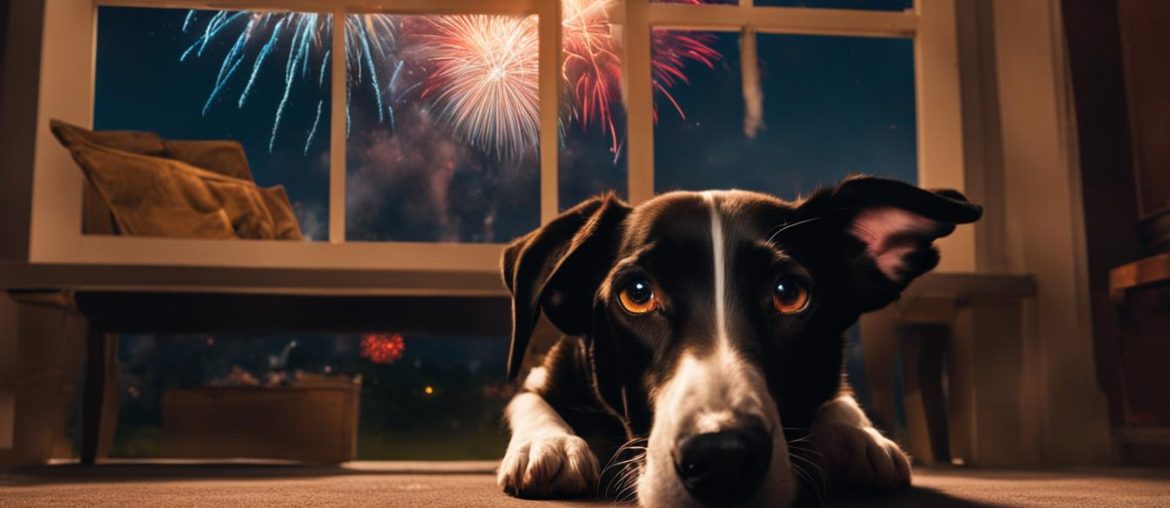Dogs are often scared of fireworks due to the loud, unpredictable noises and flashing lights. Their exceptional hearing makes the noise particularly frightening, and the lack of understanding causes them to perceive fireworks as threatening. This triggers their fight-or-flight response, leading to behaviors such as barking, hiding, pacing, and restlessness. Many dogs feel trapped during fireworks displays, which can increase their fear. It is important to understand why dogs are scared of fireworks in order to help them cope and keep them safe.
Key Takeaways:
- Dogs are scared of fireworks due to the loud, unpredictable noises and flashing lights.
- Their exceptional hearing and lack of understanding contribute to their fear response.
- Fireworks trigger the fight-or-flight response in dogs, leading to anxious behaviors.
- Understanding the reasons behind dogs’ fear of fireworks can help in managing their anxiety.
- Creating a safe environment and using desensitization techniques can help dogs cope with their fear of fireworks.
The Impact of Loud Noises on Dogs
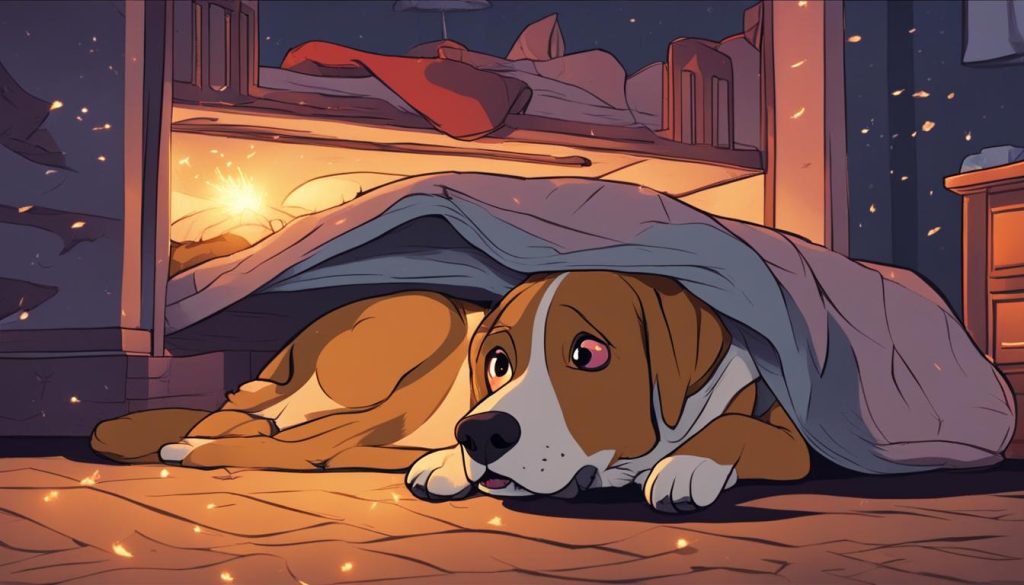
Dogs have incredibly sensitive hearing, making them more susceptible to fear from loud noises such as fireworks. The loud and unexpected sounds can startle them, leading to an increase in heart rate, adrenaline, and stress hormones. Dogs do not have the same anticipation for fireworks as they do for thunderstorms, which can make the experience more intimidating. Some dogs may be naturally easy-going or have been exposed to enough noises during their development to not be afraid of fireworks. However, for many dogs, fireworks cause stress and anxiety.
Research has shown that dogs’ fear of loud noises, including fireworks, can have both short-term and long-term effects. These effects can range from temporary behavioral changes such as barking, hiding, and restlessness to more severe symptoms of anxiety and phobia. Dogs may exhibit avoidance behaviors, such as trying to escape or seeking comfort from their owners, during fireworks displays.
To better understand the impact of loud noises on dogs, researchers have conducted various studies. One study found that dogs exposed to firework sounds exhibited increased signs of stress compared to dogs in a control group. Another study discovered that dogs who were exposed to fireworks during their early development stages were more likely to develop a fear of loud noises later in life. These findings highlight the significant influence of loud noises, such as fireworks, on dogs’ emotional and behavioral well-being.
Table: Effects of Loud Noises on Dogs
| Short-term Effects | Long-term Effects |
|---|---|
|
|
Reasons for Fear of Fireworks
Dogs can experience a phobia of fireworks due to several reasons. Firstly, the loud and unexpected noises created by fireworks can startle them, triggering their fear response. Dogs have a heightened sense of hearing, so the loud booms can be particularly overwhelming for them. Additionally, the flashing lights and unpredictable nature of fireworks can further contribute to their fear and anxiety.
Another reason why dogs may be scared of fireworks is the association they make between the noises and a perceived threat. Dogs do not have the cognitive ability to understand that fireworks are harmless entertainment, and instead, they may interpret the noises as something dangerous or threatening. This triggers their fight-or-flight response, leading to anxious behaviors such as barking, hiding, or restlessness.
Furthermore, the feeling of being trapped can also add to a dog’s fear of fireworks. When dogs are unable to escape the loud sounds, they may become even more anxious and stressed. This is why it’s essential to provide a safe environment for dogs during fireworks displays, where they can feel secure and protected.
Table: Factors Contributing to Dogs’ Fear of Fireworks
| Factors | Impact |
|---|---|
| Loud and unexpected noises | Startle dogs and trigger fear response |
| Flashing lights and unpredictability | Contribute to fear and anxiety |
| Association of noises with threat | Dogs interpret fireworks as something dangerous |
| Feeling of being trapped | Increases anxiety and stress |
Understanding the reasons behind dogs’ fear of fireworks is crucial for developing effective strategies to help them cope and alleviate their anxiety. By creating a safe environment, providing reassurance, and using desensitization techniques, owners can support their dogs during fireworks displays and help them feel more secure.
Providing a Safe Environment
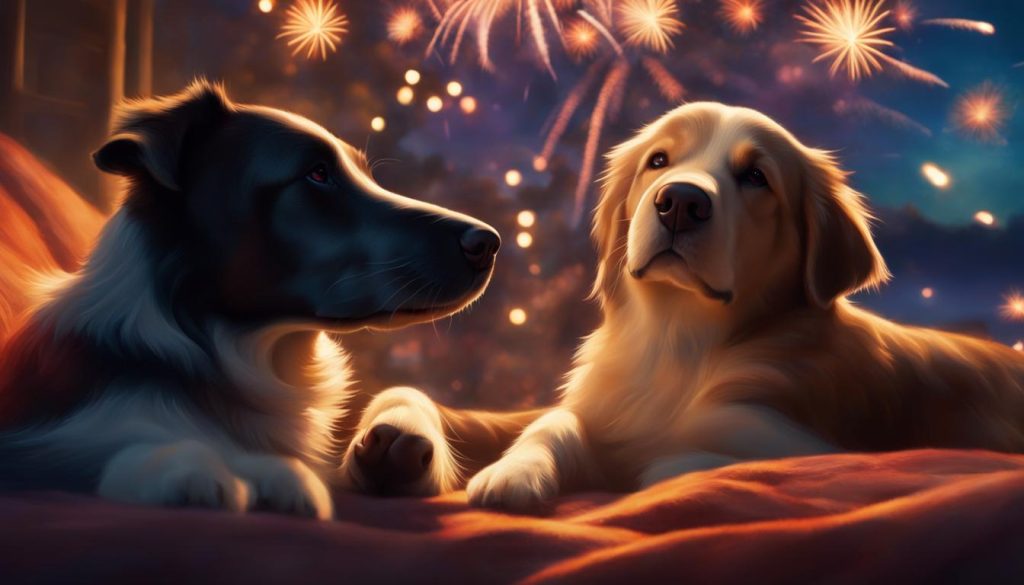
When it comes to comforting dogs during fireworks, providing a safe environment is crucial. The loud noises and bright lights of fireworks can be incredibly distressing for dogs, so it’s important to take steps to keep them calm and secure. One of the first things you can do is keep your dog indoors during fireworks displays. This will prevent them from running off and potentially getting lost or injured. Creating a quiet and comfortable space for your dog, such as a crate or a designated room, can also help to minimize their anxiety. Consider playing calming music or white noise to drown out the sound of the fireworks and provide a soothing atmosphere.
In addition to creating a safe space indoors, there are a few other measures you can take to ensure your dog’s safety. It’s important to make sure that your dog is wearing a collar with up-to-date ID tags. This will help to identify them if they do manage to escape during fireworks. Microchipping your dog is also highly recommended, as it provides a permanent form of identification that cannot be lost or removed. In case your dog does go missing, having them microchipped significantly increases the chances of being reunited with them. It’s important to remember that even the most well-behaved and normally calm dogs can become frightened and anxious during fireworks, so taking these precautions is essential.
| Key Points for Providing a Safe Environment |
|---|
| Keep dogs indoors during fireworks displays |
| Create a quiet and comfortable space for your dog |
| Play calming music or white noise to drown out fireworks noise |
| Ensure your dog is wearing a collar with up-to-date ID tags |
| Consider microchipping your dog for permanent identification |
By following these guidelines and providing a safe environment for your dog, you can help to minimize their anxiety and keep them as calm as possible during fireworks displays.
Desensitization Techniques
Dogs can benefit from desensitization techniques to help them overcome their fear of fireworks. Desensitization involves gradually exposing dogs to the sound of fireworks at a low level and pairing it with positive experiences. This process should be started well in advance of firework-heavy holidays to allow for proper training. Slowly increasing the volume of the fireworks sounds during these training sessions can help dogs become more comfortable with the noise.
Another desensitization technique is to use recorded sounds of fireworks and play them at a low volume while engaging in activities that the dog enjoys, such as playtime or training. This helps to create positive associations with the fireworks sounds, reducing fear and anxiety over time.
| Desensitization Techniques | Benefits |
|---|---|
| Gradual exposure to fireworks sounds | Helps dogs become more comfortable with the noise |
| Pairing fireworks sounds with positive experiences | Creates positive associations and reduces fear |
| Using recorded sounds of fireworks during enjoyable activities | Helps dogs associate the sounds with positive experiences |
It is important to note that desensitization should be done gradually and at the dog’s own pace. Pushing a dog too quickly or exposing them to loud fireworks sounds without proper preparation can actually intensify their fear and anxiety.
Desensitization techniques can be highly effective in helping dogs overcome their fear of fireworks. However, it is important to consult with a professional dog trainer or behaviorist to ensure that the desensitization process is carried out correctly and safely.
Importance of Identification
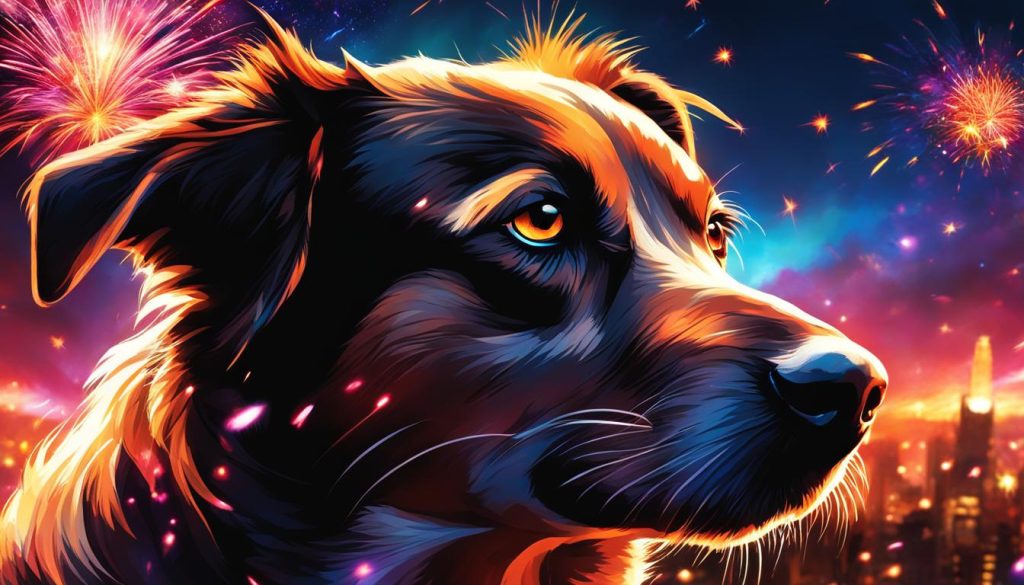
When it comes to managing a dog’s fear of fireworks, one crucial aspect that often gets overlooked is the importance of identification. During fireworks displays, dogs may become frightened and attempt to escape, increasing the risk of them running away and getting lost. To ensure their safety, it’s crucial to take proactive measures to easily identify and contact your dog in case they go missing.
One effective way to enhance identification is through microchipping your dog. A microchip is a small implant placed under the dog’s skin, which contains a unique identification number. If a lost dog is found and taken to a veterinary clinic or shelter, they can use a scanner to read the microchip and retrieve the owner’s contact information. Microchipping significantly increases the chances of reuniting with your beloved pet.
In addition to microchipping, it’s essential for dogs to wear a collar with up-to-date identification tags. These tags should include your contact information, such as your phone number and address. Having visible ID tags ensures that even if someone finds your dog on the spot, they can quickly contact you to arrange a safe return home.
| Benefit | Explanation |
|---|---|
| Increased Chance of Reunion | Microchipping and ID tags greatly increase the likelihood of your dog being returned to you if they go missing during fireworks displays. |
| Peace of Mind | Knowing that your dog can be easily identified and contacted provides peace of mind during firework events, reducing stress and anxiety for both you and your pet. |
| Compliance with Laws | In many places, it is a legal requirement for dogs to be microchipped and have ID tags. Ensuring your dog’s identification is up to date keeps you in compliance with local regulations. |
Remember, it’s especially important to double-check that your contact information is current and accurate. If you’ve recently moved or changed phone numbers, make sure to update your dog’s microchip and ID tags accordingly. By taking these measures, you can help reduce the fear and anxiety your dog experiences during fireworks displays, knowing that they can be easily identified and safely returned to you.
The Role of Early Life Conditioning
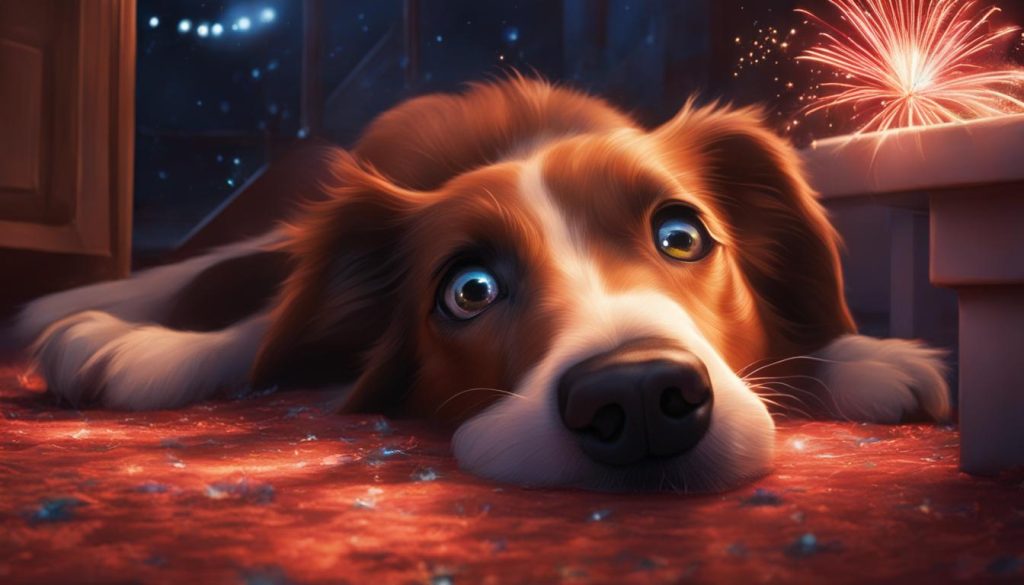
Early life conditioning plays a significant role in a dog’s sensitivity to sound, including their fear of loud noises such as fireworks. Puppies undergo critical stages of development where their brains form associations that can influence their behavior later in life. For example, if a puppy experiences a loud noise while being left alone, they may associate that noise with abandonment and develop a fear response. This early conditioning can make dogs more susceptible to fears, including the fear of fireworks.
In addition to individual experiences, genetics can play a role in a dog’s fear of loud noises. Just like humans, dogs can inherit a predisposition to stress, anxiety, and fear. Dogs with higher cortisol levels, a stress hormone, have been found to exhibit high rates of fear behaviors when exposed to loud noises, such as fireworks. Moreover, stress experienced by a mother during pregnancy can pass on a propensity for anxiety to her offspring, further impacting their fear response.
Understanding the role of early life conditioning and genetics in a dog’s fear of loud noises is crucial for effectively managing their anxiety. By addressing these underlying factors and implementing appropriate training and behavior modification techniques, such as desensitization and counterconditioning, it is possible to help dogs overcome their fear of fireworks and other loud noises.
The Influence of Genetics and Stress
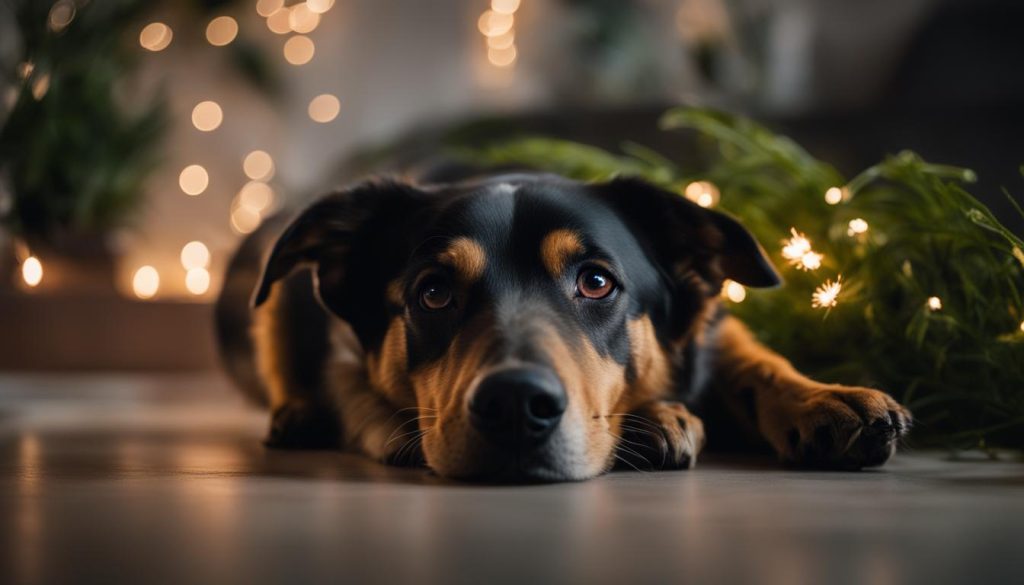
Dogs’ fear of loud noises, including fireworks, can be influenced by a combination of genetics and stress. Just like humans, dogs can inherit a predisposition to stress, anxiety, and fear. High levels of stress experienced by a mother during pregnancy can pass on a propensity for anxiety to her offspring. This is due to the influence of stress hormones, such as cortisol. Dogs with higher cortisol levels have been found to exhibit high rates of fear behaviors when exposed to loud noises, such as fireworks.
Genetics alone, however, do not solely determine a dog’s fear response. Environmental factors, such as early life experiences and ongoing stress, can also play a significant role. Dogs that have been exposed to traumatic experiences, abuse, or neglect may be more prone to fear and anxiety, including fear of loud noises like fireworks.
Please be aware that not all dogs will have the same fear response, even if they share similar genetics or experience similar levels of stress. Individual differences can arise from various factors such as breed, age, sex, reproductive status, length of time with an owner, and early exposure to loud noises. These differences highlight the complexity of fear responses in dogs and the need for tailored approaches to help each individual dog manage their fear of fireworks.
Genetics and Stress Factors Influencing Dogs’ Fear of Fireworks
| Factors | Influence |
|---|---|
| Genetics | Can inherit a predisposition to stress, anxiety, and fear |
| Stress Hormones | High cortisol levels linked to higher rates of fear behaviors |
| Early Life Experiences | Exposure to traumatic experiences, abuse, or neglect can increase fear and anxiety |
| Environmental Stress | Ongoing stress can contribute to a dog’s fear response |
| Individual Differences | Breed, age, sex, reproductive status, length of time with an owner, and early exposure to loud noises can impact fear response |
Understanding the influence of genetics and stress on a dog’s fear of fireworks can help guide strategies for reducing their anxiety. By providing a supportive environment, using desensitization techniques, and seeking the assistance of a professional trainer or behaviorist if needed, dog owners can help their furry companions feel more secure and comfortable during firework displays.
Individual Differences in Fear Response
When it comes to dogs and their fear of fireworks, it’s important to recognize that not all dogs react the same way. There are several factors that can influence how a dog responds to the loud noises and flashing lights. Breed, age, sex, reproductive status, length of time with an owner, and early exposure to loud noises all play a role in a dog’s fear response. For example, older dogs may have a heightened fear response due to age-related changes in hearing, while dogs that have been bred by their owners have a reduced risk of fear compared to those with a second owner.
Understanding these individual differences can help dog owners develop strategies to reduce their pet’s fear of fireworks. By recognizing that each dog is unique, owners can tailor their approach to calming their dog during fireworks displays. Some dogs may benefit from desensitization techniques, while others may find comfort in a safe environment or the use of calming aids. By taking into account these individual differences, owners can provide the most effective support for their furry friends.
| Breed | Age | Sex | Reproductive Status | Length of Time with Owner | Early Exposure to Loud Noises | |
|---|---|---|---|---|---|---|
| Factors | Can influence fear response | Can influence fear response | Can influence fear response | Can influence fear response | Can influence fear response | Can influence fear response |
| Example | Some breeds may be more prone to fear | Older dogs may have heightened fear due to age-related changes in hearing | Some studies suggest males may be more prone to fear | Reproductive status may impact fear response in female dogs | Dogs that have been with their owners since puppyhood may have reduced fear | Early exposure to loud noises can either increase or decrease fear response |
By recognizing and understanding the individual differences in fear response, dog owners can take proactive steps to help reduce their pet’s fear of fireworks. Whether it’s through desensitization training, providing a safe environment, or using calming aids, there are various strategies that can be employed. The goal is to create a sense of security and comfort for dogs during fireworks displays, allowing them to better manage their anxiety and fear.
Effective Strategies for Managing Fireworks Fear
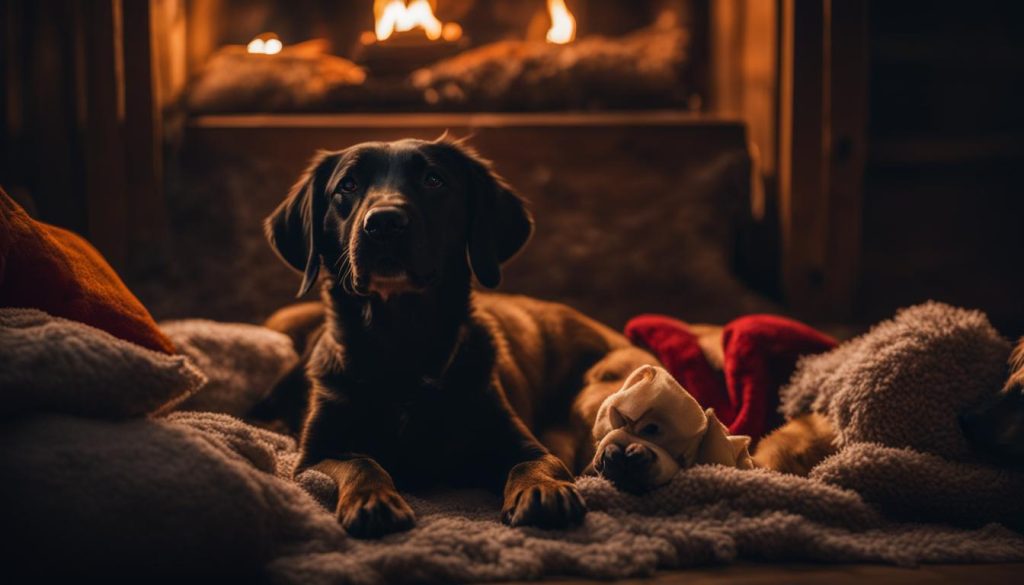
Dealing with dog anxiety during fireworks displays can be challenging, but there are several effective strategies that can help alleviate their fear and keep them calm. By implementing the following techniques, you can create a positive environment for your furry friend and help them cope with the loud noises and flashes of light:
1. Provide a Safe Space
Creating a safe and comfortable environment can make a big difference in helping dogs manage their anxiety during fireworks. Set up a designated area in your home where your dog feels secure, such as a crate or a small room. Fill the space with familiar items, like their favorite toys and blankets, and play calming music or white noise to drown out the noise from fireworks. This safe space will provide them with a sense of security and help reduce their anxiety.
2. Use Calming Aids
Calming aids, such as thundershirts, can help provide relief for dogs during fireworks displays. These specially designed vests apply gentle pressure to your dog’s body, similar to a reassuring hug, and can help reduce anxiety. Additionally, there are calming supplements and natural remedies available that can help relax your dog and make them feel more at ease. Consult with your veterinarian to determine the best options for your specific dog.
3. Counterconditioning and Desensitization
Counterconditioning and desensitization techniques can be highly effective in helping dogs overcome their fear of fireworks. Gradually exposing your dog to fireworks sounds at a low volume while providing positive reinforcement, such as treats or playtime, can help them associate the noise with something positive rather than something to fear. Over time, gradually increase the volume of the fireworks sounds during these training sessions to help desensitize your dog and build their resilience.
| Effective Strategies for Managing Fireworks Fear |
|---|
| Provide a Safe Space |
| Use Calming Aids |
| Counterconditioning and Desensitization |
Dealing with dog anxiety during fireworks can be challenging, but these strategies can help your furry friend feel more relaxed and safe. Remember to remain calm and provide reassurance to your dog during fireworks displays, as they look to you for guidance and comfort. By implementing these effective strategies, you can help manage your dog’s fear of fireworks and ensure their well-being.
The Importance of Stay Calm
Reducing a dog’s fear of fireworks requires a calm and composed approach. Dogs look to their owners for reassurance, so it is crucial to remain calm during fireworks displays. Making a big fuss around the dog can reinforce their fear and anxiety, so it’s best to show them that there is no real danger. By staying calm and relaxed, you can help your dog understand that they are safe.
During fireworks displays, it is important to avoid displaying any signs of fear or anxiety yourself. Dogs are highly perceptive and can easily pick up on your emotions. If you show fear or panic, they may interpret it as confirmation that there is something to be afraid of. On the contrary, if you remain calm and composed, your dog will take cues from you and learn that there is no real danger.
Remember that managing a dog’s fear of loud noises, such as fireworks, requires patience and consistency. It is important to create a peaceful and secure environment for your dog, ensuring they have a safe space to retreat to if they feel overwhelmed. By staying calm yourself, you can provide the stability and reassurance your dog needs to manage their fear effectively.
Wrapping Up
Dogs are often scared of fireworks due to the loud noises, unpredictability, and perceived threat. Their acute hearing and lack of understanding contribute to their fear response. However, there are various strategies and techniques that can help dogs cope with their fear of fireworks.
To reduce dog fireworks fear, it is important to create a safe environment for them during fireworks displays. Keeping dogs indoors can prevent them from running away and getting lost. Providing a safe space with calming music or white noise can help reduce their anxiety. Additionally, using calming aids such as thundershirts can provide comfort to dogs.
To help dogs overcome their fear of fireworks, desensitization techniques can be effective. Gradually exposing them to fireworks sounds at a low level and pairing it with positive experiences can help them become more comfortable with the noise. Starting this training well in advance of firework-heavy holidays is crucial.
By understanding the reasons behind dogs’ fear of fireworks and implementing appropriate measures, such as creating a safe environment and using desensitization techniques, owners can reduce their dogs’ anxiety and help them cope with fireworks displays.
FAQ
Why are dogs scared of fireworks?
Dogs are scared of fireworks due to the loud, unpredictable noises and flashing lights. Their exceptional hearing makes the noise particularly frightening, and the lack of understanding causes them to perceive fireworks as threatening. This triggers their fight-or-flight response, leading to behaviors such as barking, hiding, pacing, and restlessness.
How can I help my dog cope with their fear of fireworks?
There are several strategies to help dogs cope with their fear of fireworks. Providing a safe environment by keeping them inside during displays and creating a calm space with soothing music or white noise can help reduce anxiety. Calming wraps or vests that apply light, constant pressure can also provide comfort. Additionally, desensitization training, starting well in advance of firework-heavy holidays, can gradually expose dogs to the sounds while pairing them with positive experiences.
What can I do to keep my dog safe during fireworks displays?
To keep your dog safe during fireworks displays, it is important to ensure they are easily identified and contacted in case they run away. Getting them microchipped and ensuring they are wearing a collar with up-to-date ID tags can greatly increase their chances of being reunited with you. Creating a safe environment indoors, such as a crate or a small room, can also prevent them from running away and getting lost.
How does early life conditioning affect a dog’s fear of fireworks?
Early life conditioning plays a significant role in a dog’s sensitivity to sound. If a puppy experiences a loud noise while being left alone, they may develop a fear response to that noise. This early conditioning can make dogs more susceptible to fears, including the fear of fireworks.
Are all dogs afraid of fireworks?
No, not all dogs are afraid of fireworks. Individual differences in fear responses can be influenced by factors such as breed, age, sex, length of time with an owner, and early exposure to loud noises. Dogs that have been bred by their owners have a reduced risk of fear compared to those with a second owner. Additionally, older dogs may have a heightened fear response due to age-related changes in hearing.
How can I manage my dog’s fear of fireworks effectively?
The most effective strategies for managing a dog’s fear of fireworks include prevention, clear communication, and creating a positive environment. Preventing fear from developing through counterconditioning and desensitization is crucial. Clear communication through calm behavior and reassurance can help dogs understand that there is no real danger. Creating a positive environment with treats, toys, and calming aids such as thundershirts can also help alleviate anxiety.
Why is it important to stay calm during fireworks displays?
Dogs look to their owners for reassurance, so it is important to remain calm during fireworks displays. Making a big fuss around the dog can reinforce their fear, so it’s best to show them that there is no real danger. Stay calm and relaxed to help your dog understand that they are safe. Remember that dogs take cues from their owners, so staying calm yourself is essential in helping your dog manage their fear of fireworks.


